bmt’s TPEG Ecosystem
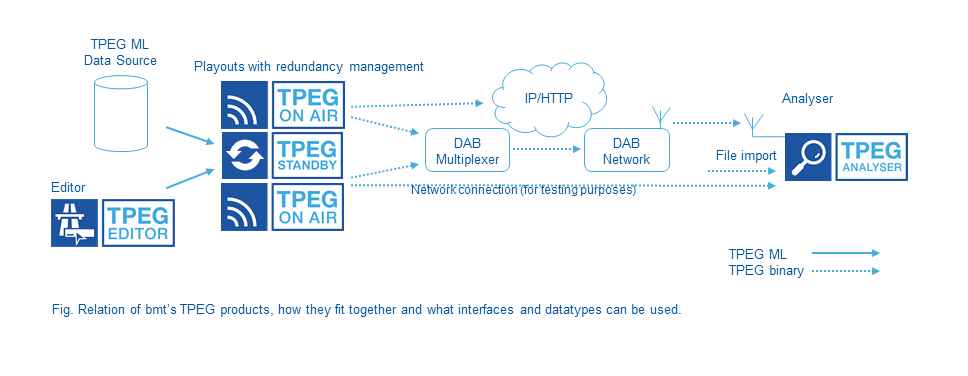
TPEG ON AIR
The Solution for Generating TPEG Services
The modular TPEG ON AIR system enables simple creation of TPEG services.
Various inbound information can be converted, multiplexed and played out to different networks (DAB/DAB+, DMB, UMTS, …). TPEG ON AIR is always updated to reflect the current TPEG specifications as issued by TISA. It supports all current DAB/DMB playout systems, works with encryption and offers new internet-based “TPEG over HTTP” output modes.
Key facts:
- Universal tool either for testing or regular services (one for lab use and one for productive use i.e. broadcasting for customers)
- Broadcast or http delivery
- Different license models
- HECA encryption/TPEG-LTE encryption/Zlib compression/TPEG-PAC access control
- Web based configuration and status monitoring (SNMP/JSON web service)
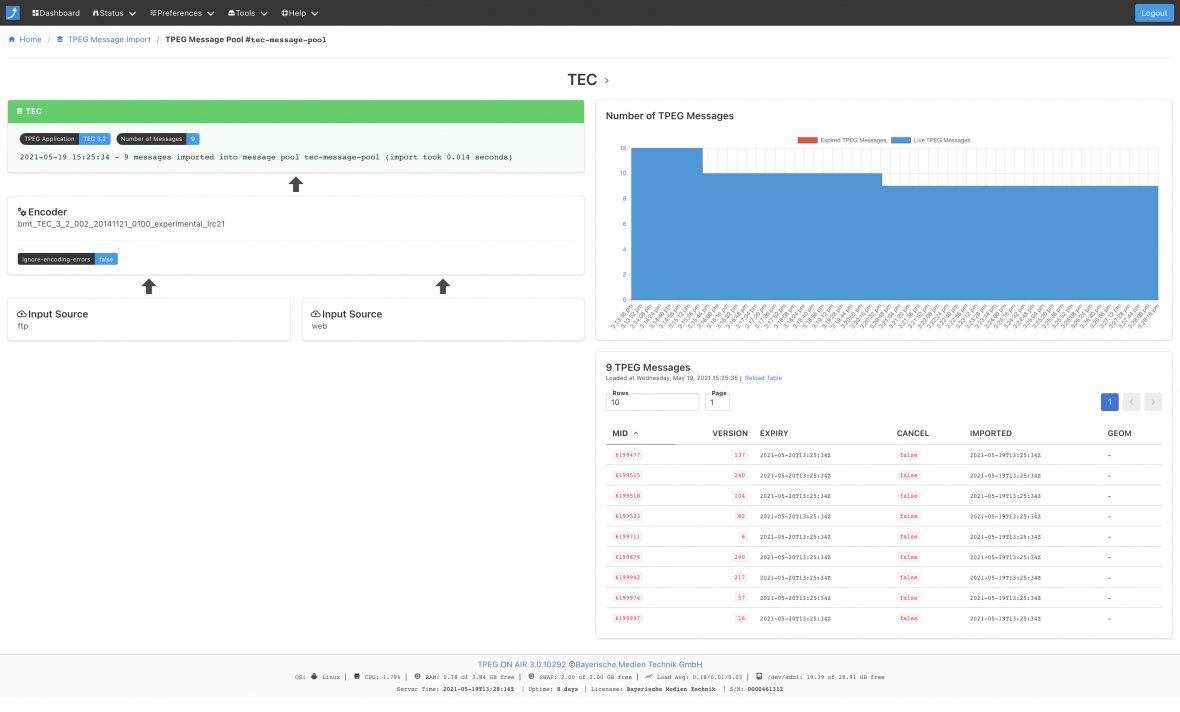
The input format is tpegML and outputs for most DAB Multiplexers/content servers (Fraunhofer, Radioscape, Factum, Digidia) are available. TPEG ON AIR is used for the commercial TPEG services in Germany, UK, Netherlands, Belgium and Norway and is tested in various countries worldwide. The test playout is technically identical to the productive license, so all tests are compliant to the output in the networks mentioned above.
TPEG ON AIR is delivered as a stand-alone application. It can be run either on Windows or Linux as a Desktop application or service and is managed via a Web interface. Scalability, availability and easy recovery can be ensured by virtualisation.
TPEG ON AIR 3.0 now available
New features and changes (by Oct. 2019):
- Now delivered as stand-alone application
- New web interface
- Runs on Windows and Linux, as desktop application or service
- Support for HTTP upload of TPEGML messages
- Support for GEWI’s TIC3-XML (TEC and TFP) as import format
- Support for TEC 3.3, SPI 1.0 and EAW 1.0
- New service component multiplex algorithm: Dynamic bandwidth reconfiguration, in dependence of the number of current messages
- New time-sharing message multiplex algorithm: Broadcast all messages within a time frame
- Multi-pass ZLIB compression
- Support for TomTom TrafficService (extra charge)
TPEG STANDBY
New redundancy option for bmt’s TPEG ecosystem
With TPEG STANDBY, bmt now provides a TPEG playout redundancy system to guarantee 24/7 TPEG traffic message provisioning. In case of network outages or computer failures, TPEG STANDBY switches between two or more TPEG ON AIR playouts fully automatically, to enable seamless provisioning of TPEG data to end user devices.
TPEG STANDBY permanently monitors connectivity and system health of all TPEG ON AIR playouts and supported DAB multiplexers and goes live in case of failures. Switching manually to another TPEG playout is supported, as well.
Errors are displayed on the graphical user interface and forwarded to the network management system using the SNMP protocol. An archive of errors is kept, for later investigation.
Since January 2022 TPEG STANDBY is successfully operating at Bayerischer Rundfunk (Bavarian Broadcasting Cooperation).
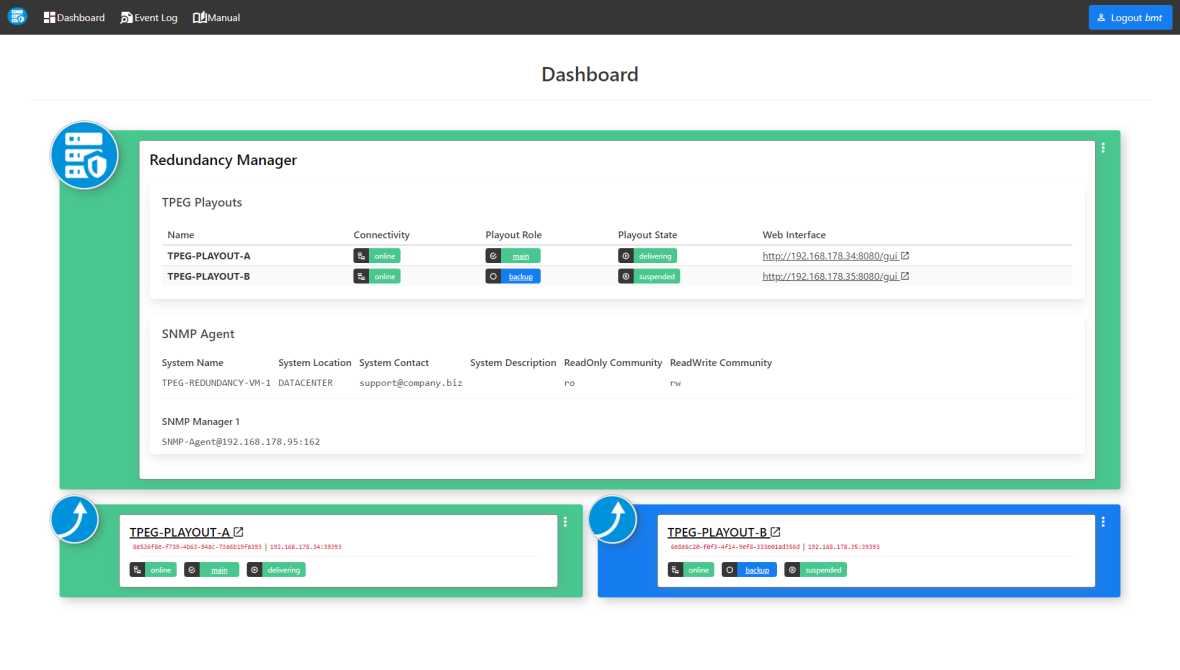
TPEG Analyser
The TPEG Analyser allows the graphical representation and interpretation of several data streams in real time, as well as the interpretation of recorded data. Meaningless byte data streams turn into TPEG data blocks that are easy to analyse. At first glance differences between the various services can be spotted, and the most important parameters can be compared.
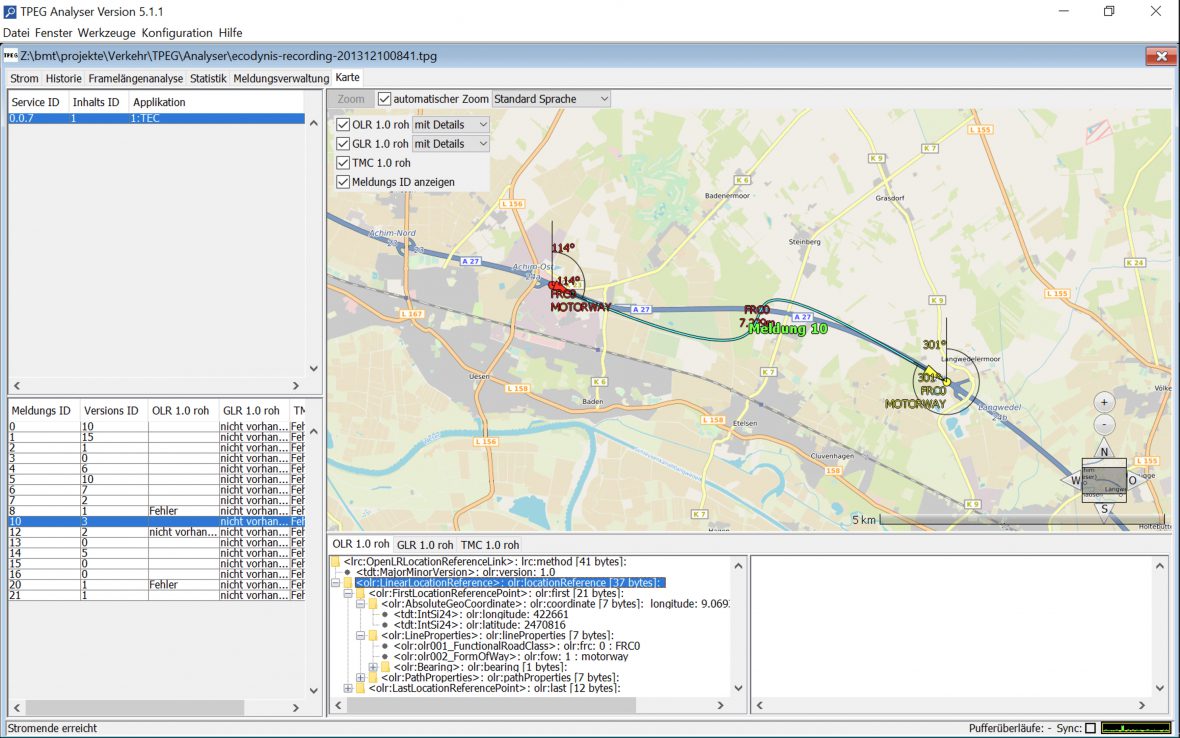
The effective solution for following applications:
- Monitoring and controlling TPEG services
- Visualising and recording TPEG services
- Comparing TPEG services
- Quality assurance and debugging
- Reference information for the development of devices and terminals
- Testing TPEG encoders
Product features:
- As data source files, DAB receivers and network streams can be used
- Simultaneous representation of bandwidth, synchronisation and reception for several services
- Animated visualisation of the different TPEG transport frames in real time
- Detailed output of the decoded frame content
- Plug-in concept for error warnings and further content analysis
Most encrypted TPEG services can be decrypted in the TPEG Analyser as long as the service provider does allow it. We are able to provide decryption plugins in coordination with the service provider for testing purposes. Please contact us in case of questions.
New features of the TPEG Analyser 5.1
- Added MapPlugin, including support for GLR, OLR and TMC to be shown in a map
- Added support for OLR relative coordinate decoding
- Added support for opening recently used data
- Added enable/disable of plugins to the plugin-dialog instead of moving plugins into/from plugins-folder
- Added check for unused bits in selectors set to false
- Message management export file name suggestions has attached timestamp of save time
Previous versions
TPEG Viewer
All TPEG information at a glance
The TPEG Viewer allows the quick visualisation of TPEG messages even without deep knowledge of the TISA standards. Whether for traffic editors, mobility service providers or device manufacturers, the TPEG Viewer decodes messages in form of real-time IP data streams or uploaded data files and displays them in an appealing web interface.
Compared to bmt’s TPEG Analyzer, which provides in-depth debugging, versioning and analysing of the complete message history, the TPEG Viewer allows all live messages to be displayed quickly and attractively. TPEG Viewer supports both a map and a table view, and both views fully support textual search and filtering. Easy-to-understand icons, plain text messages and various digital maps and georeferencing models ensure the flexible use of this visualisation tool.
The TPEG Viewer is hosted and operated in the bmt cloud. The tool does not need to be installed or updated locally. Instead, it is operated by the user via a web browser
Core element of the TPEG Viewer is bmt’s TPEG DecoderLibrary, which decodes TPEG binary streams and TPEGml data. The library ensures that the decoding is compliant with the specifications issued by TISA and all applications are available in the current version.
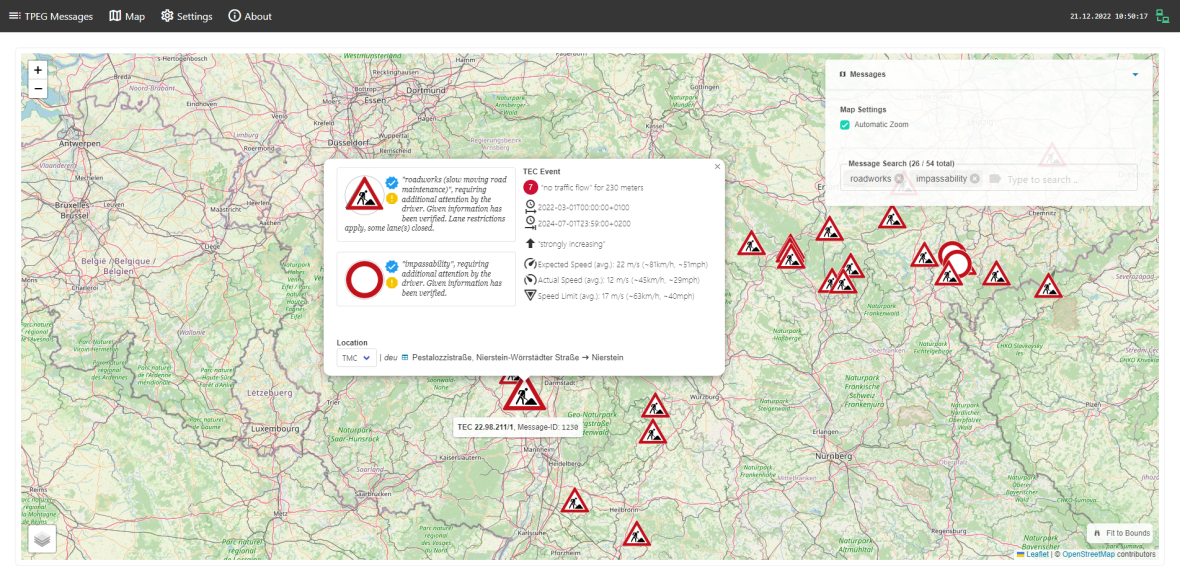
TPEG Editor
Create your own TPEG test messages
The TPEG Editor is a tool for the creation and modification of TPEG files. It can be used to open TPEG files and present their content in a clearly laid out user interface where all fields can be edited. Missing or invalid parameters which would cause non-standard TPEG output are indicated by red background colour which facilitates trouble-shooting. Optional parameters are marked or suppressed in order to facilitate the creation of new messages. Messages are managed in multiple versions and new versions can be cloned from previous ones. The location of a message can be modelled using all TISA location referencing methods. Additionally, TMC, GLR and OLR locations can be edited and graphically shown on a map. The TPEG Editor supports all applications currently specified by TISA and will be enhanced with future applications after their release. bmt’s long-term expert knowledge ensures that the output is compliant to the related TPEG2 specifications.
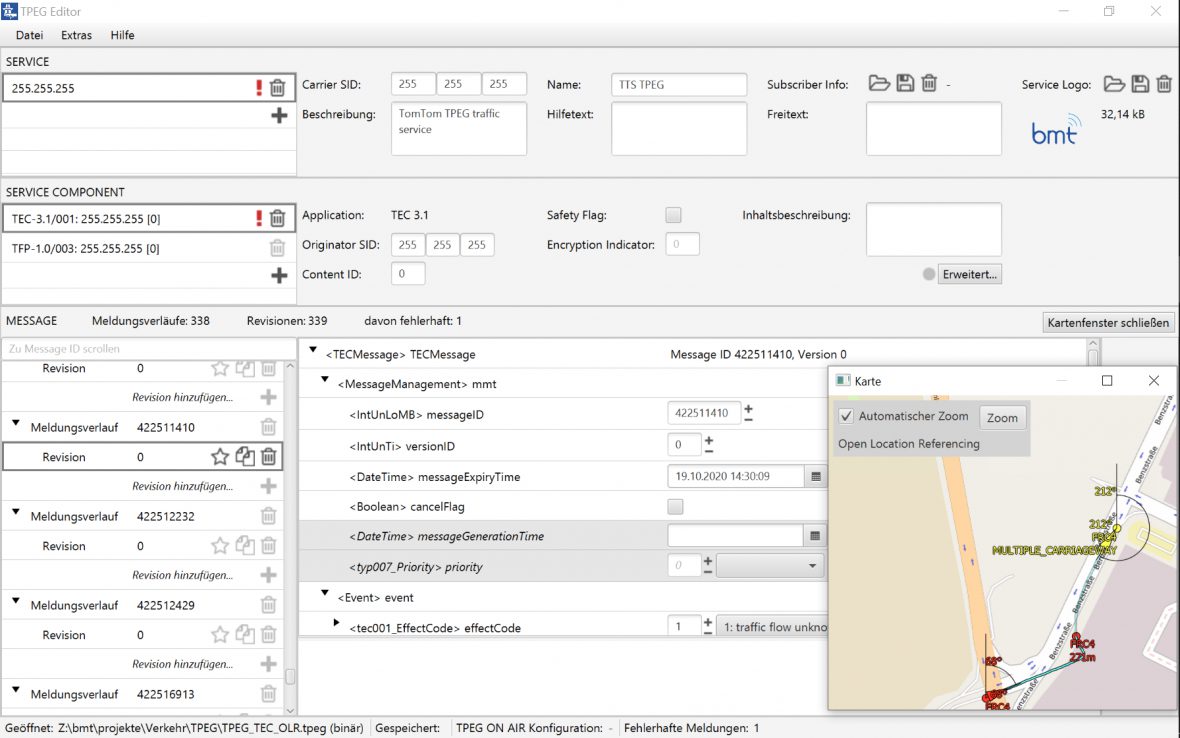
The creation of test cases for TPEG-enabled devices in a lab environment is important for development engineers, test engineers and service providers. The TPEG Editor simplifies this task significantly and makes sure that the output is syntactically correct.
A set of messages is stored as a TPEGml file which can be reloaded and modified later. The TPEGml output can also be fed into a TPEG ON AIR test or productive system for immediate update of a TPEG stream or a binary file.
For a later release the playback of predefined scenarios with updates, changes and deletions of messages is planned.
TPEG Editor 3.0 now available
New features and changes are (by Feb. 2019):
- Binary Fileoutput (extra charge)
- New application: TEC 3.3
- HERE background map
- Adding TPEG data to current inventory
- Loading recently used files
- Calculation of linear distance (for OLR Distance Metres)
- Map cache for offline usage
Previous version
Folgende Aufzählungen sollen nicht offen gezeigt werden, sondern sich erst wie eine mehr Funktion nach dem Anklicken nach unten öffnen
TPEG Decoder Library
TPEG Decoder Library – The fast lane to your TPEG implementation
The bmtTPEGDecoderLibrary enables Java developers to easily process TPEG binary streams and – as an option – even TPEGml data. All processing of the TPEG framing, SNI (Service and Network Information) and message management (MMC) is done by the library and the resulting information (Services, Service Components and Messages) is provided by an easy-to-access API.
For usage of the library, a developer has only to provide one or more TPEG inputs and registers listeners for services as well as listeners for Service Component Messages. All TPEG content will be provided as Java objects and can be accessed without knowledge of the actual TPEG binary or TPEGml encoding. An application, based on the library, can perform its own TPEG Message Management or can use the built-in message management in order to get informed about new, updated, canceled or expired TPEG Messages.
In addition, there are optional extensions to the bmtTPEGDecoderLibrary, which allow the extraction of TPEG Binary streams from DAB subchannels or a TPEG Service Component tuning via DAB (DAB-Tuning implementation must be provided according to a defined DAB-Tuner interface API). Also an extension for providing the TPEG-OLR objects to the TomTom OpenLR decoder is available.
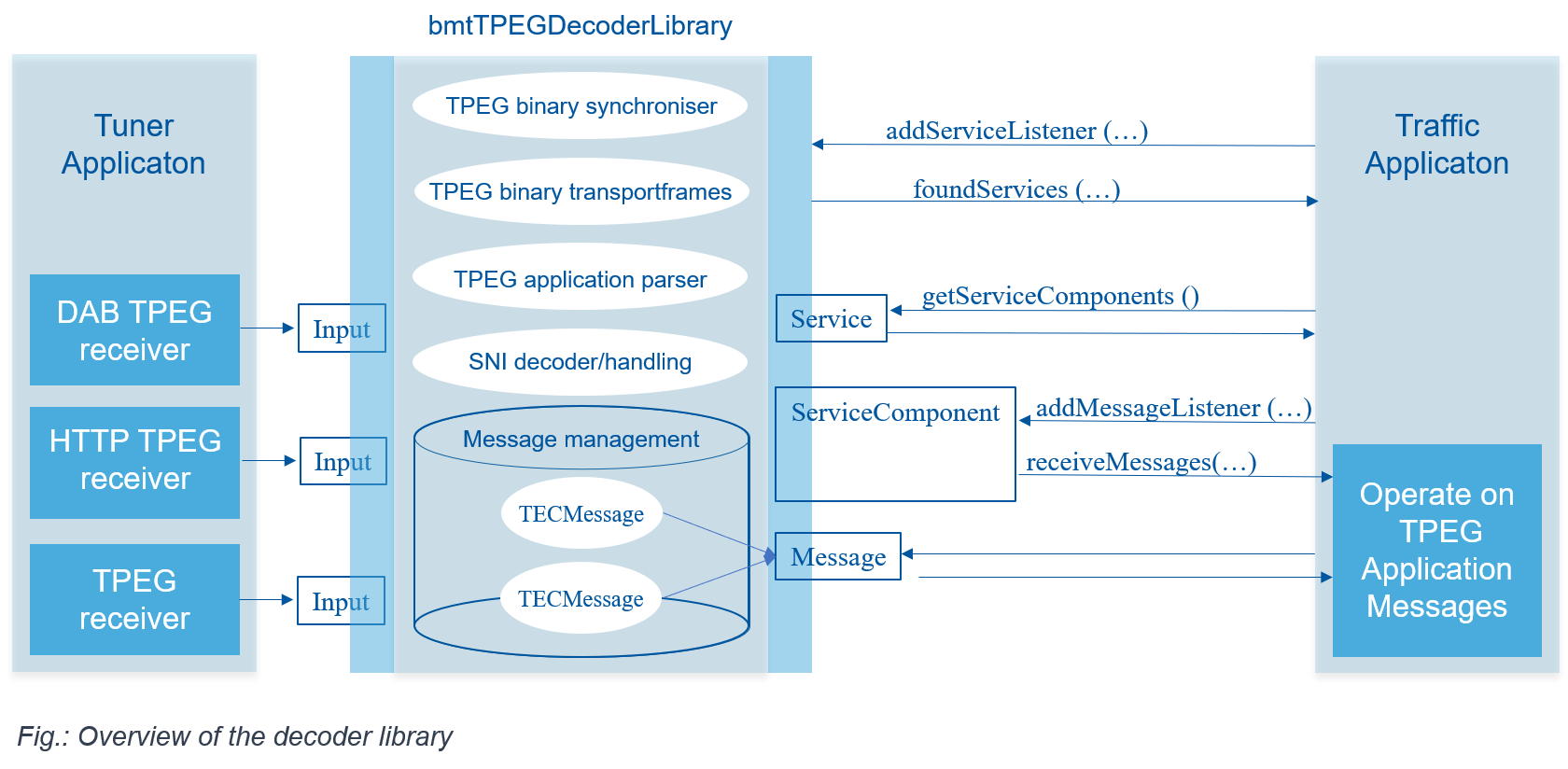
The decoding of TPEG services is a complex task that is time-consuming and error-prone. The decoder library is thus the ideal tool to create an application based on TPEG without the need to know the specifications in depth.
Access through the high level API reduces the implementation and test period for your Java/Android applications. bmt’s TPEG know-how ensures that the implementation is compliant with the specifications issued by TISA and new applications are available promptly after their release.
Consulting
Bayerische Medien Technik’s client’s for its consulting services include terminal device manufacturers, broadcast network operators, content and service providers as well as the auto industry.
Among other clients, bmt works for almost every car manufacturer on the optimisation of TPEG to reflect their requirements. Our core competence lies in the convergence of modern broadcast media with traffic information systems.
A variety of modern communication and information technologies interact here. Therefore we provide a wide range of know how. bmt also conducted a study on behalf of the MOST-Cooperation regarding the „Optimisation of TPEG Integration“.
Parallel to the consulting activities we offer development and prototyping within certain fields.
Now available: „TPEG-LAB by bmt“
Do you need to test your navigation unit under real conditions? The TPEG-LAB by bmt is the testing solution for devices using pre-configured data sets, real over-the-air data and/or data defined by you or your customer. TPEG over DAB, HTTP and combinations of the two are all available with this testing method.
The TPEG-LAB comprises all the various tools in the bmt‘s TPEG ecosystem, supported by our expert’s extensive pool of knowledge and experience. Book the TPEG-LAB for testing your devices. Simply contact sales@bmt-online.de for more information or a commercial offer.
